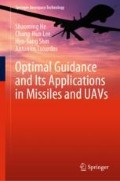Abstract
This chapter addresses the problem of energy-optimal waypoint-following guidance for an UAV with the consideration of arbitrary number of obstacles. The proposed guidance law is derived as a solution of a linear quadratic optimal control problem in conjunction with convex parameter optimization. The algorithm developed integrates path following and obstacle avoidance into a single step and is able to be applied to a general waypoint-following mission. Several particular cases of the proposed guidance law are presented to provide better insights of the proposed algorithm. Nonlinear numerical simulations clearly demonstrate the effectiveness of the proposed formulations.
Access this chapter
Tax calculation will be finalised at checkout
Purchases are for personal use only
References
Mujumdar A, Padhi R (2011) Evolving philosophies on autonomous obstacle/collision avoidance of unmanned aerial vehicles. J Aerospace Comput Inf Commun 8(2):17–41
Koren Y, Borenstein J (1991) Potential field methods and their inherent limitations for mobile robot navigation. In: Proceedings. 1991 IEEE international conference on robotics and automation. IEEE, pp 1398–1404
Hamner B, Singh S, Scherer S (2006) Learning obstacle avoidance parameters from operator behavior. J Field Robot 23(11–12):1037–1058
Scherer S, Singh S, Chamberlain L, Elgersma M (2008) Flying fast and low among obstacles: methodology and experiments. Int J Robot Res 27(5):549–574
Han S-C, Bang H (2004) Proportional navigation-based optimal collision avoidance for uavs. In: 2nd international conference on autonomous robots and agents, pp 13–15
Mujumdar A, Padhi R (2011) Reactive collision avoidance of using nonlinear geometric and differential geometric guidance. J Guid Control Dyn 34(1):303–311
Arthur Earl Bryson (2018) Applied optimal control: optimization, estimation and control. Routledge
Shaferman V, Shima T (2008) Linear quadratic guidance laws for imposing a terminal intercept angle. J Guid Control Dyn 31(5):1400–1412
Tzon-Tzer L, Shiou S-H (2002) Inverses of 2\(\times \) 2 block matrices. Comput Math Appl 43(1–2):119–129
Author information
Authors and Affiliations
Corresponding author
Rights and permissions
Copyright information
© 2020 The Editor(s) (if applicable) and The Author(s), under exclusive license to Springer Nature Switzerland AG
About this chapter
Cite this chapter
He, S., Lee, CH., Shin, HS., Tsourdos, A. (2020). Optimal Integrated Waypoint Following and Obstacle Avoidance Guidance Law. In: Optimal Guidance and Its Applications in Missiles and UAVs. Springer Aerospace Technology. Springer, Cham. https://doi.org/10.1007/978-3-030-47348-8_10
Download citation
DOI: https://doi.org/10.1007/978-3-030-47348-8_10
Published:
Publisher Name: Springer, Cham
Print ISBN: 978-3-030-47347-1
Online ISBN: 978-3-030-47348-8
eBook Packages: EngineeringEngineering (R0)

